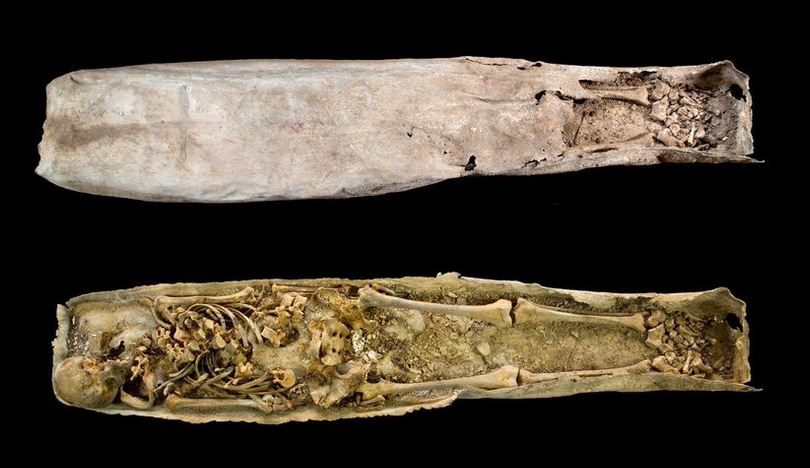Within the mysterious lead coffin at the former hastily-dug grave of King Richard III was an elderly woman, probably of high socioeconomic or religious status, researchers from the University of Leicester’s Archaeological Services (ULAS) informed.
The coffin-within-a-coffin was found in August 2013, buried just feet from Richard III at Grey Friars friary. The coffin was found inside a much bigger limestone sarcophagus (box-like funeral receptacle for a corpse, usually but not always carved in stone, and displayed above ground) during a second excavation of the site.
The skeleton of the elderly woman was found one year after the remains of King Richard III were unearthed.

The inner lead casket of the Greyfriars medieval stone coffin. (Image: University of Leicester)
Academics believe the elderly woman may have been an early benefactor (supporter) of the friary.
The lead coffin, located in the presbytery of the friary’s church (maybe close to the high altar), and the inlaid crucifix, meant she probably had a special significance to the holy Catholic order, the researchers explained.
According to radiocarbon dating, she was probably buried not long after construction of the church was completed in 1250 (however, it is possible she did not die until 1400).
The discovery is the first intact medieval stone coffin to be found in Leicester during modern excavations.
Excavation director of the Grey Friars site Mathew Morris said:
“Although it might seem unusual that Richard III is the only male skeleton found inside the Grey Friars church, the other four skeletons all being female, it must be remembered that we have only excavated five of ten identified graves in the church’s chancel with the potential for hundreds more burials elsewhere inside the church, the other friary buildings and outside in the cemetery.”
“Excavations of other monastic cemeteries have found ratios ranging from 1:3 to 1:20 woman to men buried, with urban monastic cemeteries typically having greater numbers of women buried in them than rural sites.”

Richard III (1452 – 1485) was King of England from 1483 until his death in the Battle of Bosworth Field. (Image: Wikipedia)
“In Leicester, ULAS’s excavation of the medieval parish church of St Peter (today situated beneath the John Lewis store in Leicester’s Highcross retail quarter) found that the burial of men and women inside the church was broadly equal.”
“Statistically, the sample is too small to draw any conclusions to the significance of so many women at Grey Friars. After all, if we carried out more excavations it is possible that we could find that these are the only four women buried in the church. Richard III would certainly not have been the only male buried here during the friary’s 300 year history and historic records list at least three other men buried in the church. What stands out more is the contrast between the care and attention taken with these burials – large, neatly dug graves with coffins – and the crudeness of Richard III’s grave. The more we examine it, the clearer it becomes how atypical Richard III’s burial really was.”
Video – Opening the medieval stone coffin
The high-status woman was in one of ten graves found in the grounds of the medieval complex, one of which was of Richard III. Six of them were left undisturbed. All the ones that were examined had female remains.
This month (March), Richard III will be reinterred at Leicester Cathedral after his remains are taken from the University of Leicester on Sunday March 22nd.
Video – Uncovering the Church of the Friars Minor Leicester

